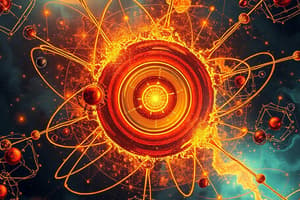Podcast
Questions and Answers
How many neutrons do carbon-12 and carbon-13 have, respectively?
How many neutrons do carbon-12 and carbon-13 have, respectively?
Carbon-12 has six neutrons. Carbon-13 has seven neutrons.
How many electrons do elements in group 1 need to lose to achieve a stable electron configuration? How many do elements in groups 14 and 17 need to gain?
How many electrons do elements in group 1 need to lose to achieve a stable electron configuration? How many do elements in groups 14 and 17 need to gain?
Elements in group 1 need to lose one electron, elements in group 14 need to gain four electrons, and elements in group 17 need to gain one electron.
Which of the following statements is false?
Which of the following statements is false?
- To be enantiomers, a molecule must have at least four different atoms or groups connected to a central carbon.
- To be enantiomers, a molecule must have at least three different atoms or groups connected to a central carbon.
- Molecules must have a double bond to be cis-trans isomers. (correct)
- Molecules with the formulas CH3CH2COOH and C3H6O2 could be structural isomers.
If xenon has an atomic number of 54 and a mass number of 108, how many neutrons does it have?
If xenon has an atomic number of 54 and a mass number of 108, how many neutrons does it have?
Atoms that vary in the number of neutrons found in their nuclei are called ________.
Atoms that vary in the number of neutrons found in their nuclei are called ________.
Potassium has an atomic number of 19. What is its electron configuration?
Potassium has an atomic number of 19. What is its electron configuration?
Which type of bond represents a weak chemical bond?
Which type of bond represents a weak chemical bond?
Which of the following statements is not true?
Which of the following statements is not true?
When acids are added to a solution, the pH should ________.
When acids are added to a solution, the pH should ________.
A molecule that binds up excess hydrogen ions in a solution is called a(n) ________.
A molecule that binds up excess hydrogen ions in a solution is called a(n) ________.
Which of the following statements is true?
Which of the following statements is true?
The presence of a membrane-enclosed nucleus is a characteristic of ________.
The presence of a membrane-enclosed nucleus is a characteristic of ________.
Which of the following is not a functional group that can bond with carbon?
Which of the following is not a functional group that can bond with carbon?
What makes ionic bonds different from covalent bonds?
What makes ionic bonds different from covalent bonds?
Why are hydrogen bonds and van der Waals interactions necessary for cells?
Why are hydrogen bonds and van der Waals interactions necessary for cells?
Flashcards are hidden until you start studying
Study Notes
Neutrons in Isotopes
- Carbon-12 contains six neutrons, while Carbon-13 has seven neutrons.
Electron Configuration and Stability
- Atoms achieve a full valence shell for stability by giving, taking, or sharing electrons.
- Group 1 elements need to lose one electron to achieve stable configurations.
- Group 14 elements need to gain four electrons, while Group 17 elements need to gain one electron.
Isomerism
- CH3CH2COOH and C3H6O2 can be structural isomers.
- Molecules must have at least four different groups connected to a central carbon to be considered enantiomers.
Neutrons in Xenon
- Xenon with atomic number 54 and mass number 108 has 54 neutrons.
Definition of Isotopes
- Isotopes are atoms with varying numbers of neutrons in their nuclei.
Potassium's Electron Configuration
- Potassium, with an atomic number of 19, has the electron configuration where shells 1, 2, and 3 are full, and shell 4 has one electron.
Types of Chemical Bonds
- Hydrogen bonds are classified as weak chemical bonds compared to covalent bonds.
Water Properties
- Water is polar, stabilizes temperature, and is essential for life.
- It is noted as the most abundant molecule in the Earth's atmosphere.
Effect of Acids on pH
- The addition of acids to a solution results in a decrease in pH.
Function of Bases
- Molecules that bind excess hydrogen ions in a solution are termed bases.
Interaction of Acids and Bases
- Acids and bases can neutralize each other, and acids can change the pH of a solution.
Eukaryotic Cells
- The presence of a membrane-enclosed nucleus is a characteristic feature of eukaryotic cells.
Carbon Bonding with Functional Groups
- Sodium is not a functional group that can bond with carbon; functional groups include hydroxyl, phosphate, and carbonyl.
Ionic vs. Covalent Bonds
- Ionic bonds involve the transfer of electrons between ions and are generally weaker than covalent bonds.
Importance of Hydrogen Bonds and Van der Waals Interactions
- Hydrogen bonds and Van der Waals interactions are crucial for the structure and function of proteins and DNA in cells.
Studying That Suits You
Use AI to generate personalized quizzes and flashcards to suit your learning preferences.




